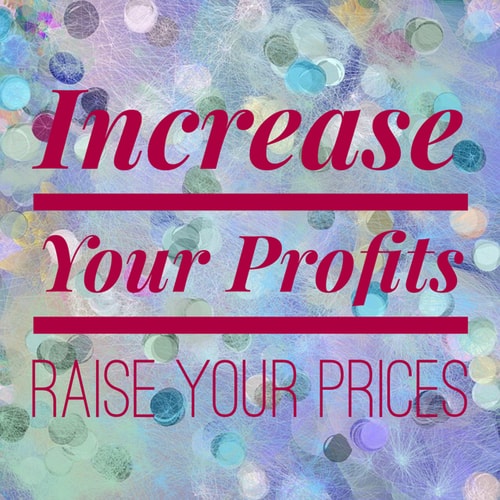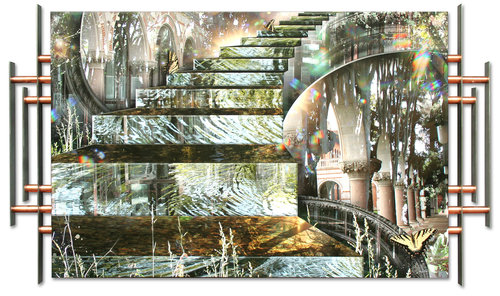by Carolyn Edlund
Want to make a better margin on everything you sell? You can grow your profit margin in two ways – decrease your costs, or raise your prices. This article shares ways to increase prices of your art or handmade work.

When should you raise prices on artwork? It might be time to consider a price adjustment if you are selling new work within a few months of creating it, and if this is a regular occurrence for at least six months. If you can’t keep up with commissions, or your work is snapped up quickly at retail, you might look to see if you are currently underpricing what you make. Art should increase in price over time, not decrease, so carefully raise your prices in small increments and gauge how this affects your sales. A 10% – 20% increase per year may make sense for you.
There are also ways to add perceived value to your work, many of which you can easily implement. This provides you additional reasons to charge more for your art.
Include a Certificate of Authenticity with each purchase
A Certificate of Authenticity will include the title, medium, materials, artist’s name and signature, and the year it was created, among other information. Often, a small image of the work is included to add further credibility. These certificates are often presented to prove provenance by galleries and auction houses, but artists can use them as well, and collectors like to receive them. They can be wonderful additions to a purchase, especially if it is a gift.
Offer limited editions
This strategy has often been used to justify a higher price. Enhance reproductions even further by overpainting or embellishing giclees or other prints and including an original signature.
Use beautiful presentation
If a piece of handmade jewelry is presented in an upscale box, it gives the impression that it is a more expensive piece. Art that is displayed in a gallery-style setting with appropriate lighting also makes impact as a higher-end work. Take a look at your display to see if you can improve the perceived value of your own art by improving your merchandising.
Add words
Recognizable words or symbols add another layer of meaning to your work, and can really connect emotionally with collectors. This can work to drive sales, make your work more collectible and increase your prices.
Add function
The more ways your work can be used, the higher the perceived value. One craftsman made large wooden jigsaw puzzles as delightful toys, but when he decided that his puzzles would make a wonderful tabletop, added legs and began to offer it as furniture, his prices skyrocketed. How many ways can your work be used? Or can you add functions by transforming what you make?
Small touches
An inscribed poem on the bottom of a ceramic pot, a beautiful lining in the pocket of a handmade jacket, or words written on the back of a painting are special touches that artists can use to enhance the desirability of their work. Sometimes no one but the owner knows it is there – it is a “secret” extra designed to enhance the experience of owning the art, and adds value.

“How Did I Get Here?” by artist Leslie Kell has a custom built frame.
Include matting and framing
When you custom mat and frame your art for the customer, you are providing an important service and should adjust the price accordingly. Mark up materials as well as charging for your labor with this added service. Or, create handmade frames specifically for your art that allow you to increase your prices. Artist Leslie Kell enhances her surreal artwork using this strategy (see image above.)
Personalization
Personalization is very popular these days, and adds value to handmade work. If your process allows you to personalize your work for clients, consider it a premium service and add a fee for this.
Commissions
Any custom-made art takes longer and is more involved, and of course requires that you charge a higher price. Give some thought to the “extras” you could offer with that commission and the fees for each of them.
Create tiers and packages
Use tiered pricing to add extras levels to a purchase. Could you include a bonus with the purchase, such as a signed coffee table book of your art? Would you be willing to make a personal appearance at an unveiling party? Buying art is an exciting experience. You can add to it with a variety of offerings that increase incrementally in complexity and price. Put together packages at different price points to appeal to different customers. Usually artists place their “sweet spot” as the middle tier, since it is most often selected by customers.
Think big
Many artists spread their price points to have something in their collection for different sized pocketbooks. Avoid thinking of this as a way to offer only lower-priced items, however. Look at the most expensive piece of art you have for sale, and consider ways that you can increase your price spread to offer even more expensive artwork. Artists who have a high-end aspirational price level on a special collection of work often find buyers who can afford it, thus earning much more on a single sale.


I sometimes find the struggle to get my unique sculptures overwhelming. Art galleries want a lot of money to show art of unknown artists and competitions etc also require money so .when you are penniless and struggling where do you look for help?
Kurtis, if art galleries are asking a lot of money to show your work, you are most likely dealing with a vanity gallery, and I wouldn’t advise that route. Why not submit to local exhibitions and get some experience there under your belt? Some have no entry fees. As you build your CV, you may be able to gain introductions to gallerists and discuss representation with them. They work on a commission basis, and you should not find that it is costing you a lot of money. Here’s an article on ways that galleries find artists https://www.artsyshark.com/2012/07/12/top-10-ways-that-galleries-find-artists/
All of these are wonderful ideas. The roadblock we’re running into is that the customer base we already have already has an expectation of the prices. Increasing the prices incrementally (which you mentioned) is the obvious solution to that.
I would agree Earnest, and there should be an expectation that prices go up over time. However, if you offer a “package” that is different from just a painting, for example, it won’t be an apples to apples comparison and you may be able to get that higher price due to a service or framing, etc.
Thank you Carolyn for alway enlightening your artists.
“Grate Wishes.”
from The Manhole Artist
Bobbi Mastrangelo